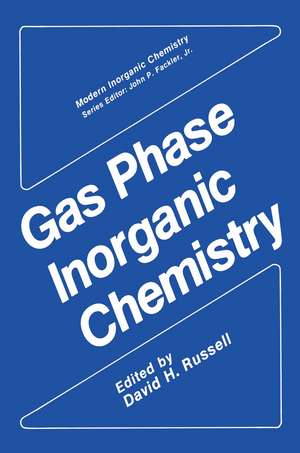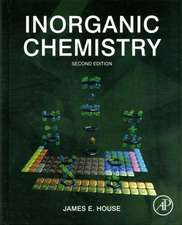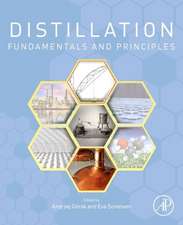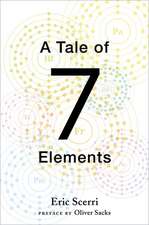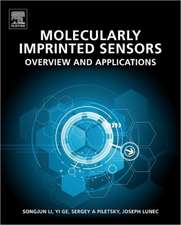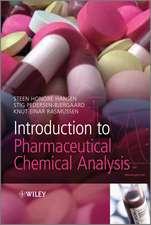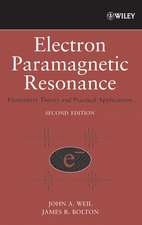Gas Phase Inorganic Chemistry: Modern Inorganic Chemistry
Editat de David H. Russellen Limba Engleză Paperback – 13 mar 2012
Din seria Modern Inorganic Chemistry
- 18%
 Preț: 1220.12 lei
Preț: 1220.12 lei - 18%
 Preț: 957.32 lei
Preț: 957.32 lei - 18%
 Preț: 957.62 lei
Preț: 957.62 lei - 15%
 Preț: 639.08 lei
Preț: 639.08 lei - 15%
 Preț: 655.78 lei
Preț: 655.78 lei - 18%
 Preț: 957.44 lei
Preț: 957.44 lei - 18%
 Preț: 1553.16 lei
Preț: 1553.16 lei - 18%
 Preț: 1245.97 lei
Preț: 1245.97 lei - 18%
 Preț: 952.89 lei
Preț: 952.89 lei - 15%
 Preț: 592.71 lei
Preț: 592.71 lei - 15%
 Preț: 640.88 lei
Preț: 640.88 lei -
 Preț: 406.63 lei
Preț: 406.63 lei - 18%
 Preț: 1241.55 lei
Preț: 1241.55 lei - 18%
 Preț: 954.77 lei
Preț: 954.77 lei - 18%
 Preț: 1239.67 lei
Preț: 1239.67 lei - 18%
 Preț: 1240.47 lei
Preț: 1240.47 lei
Preț: 394.87 lei
Nou
Puncte Express: 592
Preț estimativ în valută:
75.57€ • 82.06$ • 63.48£
75.57€ • 82.06$ • 63.48£
Carte tipărită la comandă
Livrare economică 23 aprilie-07 mai
Preluare comenzi: 021 569.72.76
Specificații
ISBN-13: 9781468455311
ISBN-10: 1468455311
Pagini: 432
Ilustrații: 428 p.
Dimensiuni: 152 x 229 x 23 mm
Greutate: 0.58 kg
Ediția:Softcover reprint of the original 1st ed. 1989
Editura: Springer Us
Colecția Springer
Seria Modern Inorganic Chemistry
Locul publicării:New York, NY, United States
ISBN-10: 1468455311
Pagini: 432
Ilustrații: 428 p.
Dimensiuni: 152 x 229 x 23 mm
Greutate: 0.58 kg
Ediția:Softcover reprint of the original 1st ed. 1989
Editura: Springer Us
Colecția Springer
Seria Modern Inorganic Chemistry
Locul publicării:New York, NY, United States
Public țintă
ResearchCuprins
1 Reactions of Atomic Metal Ions with H2, CH2, and C2H6: Electronic Requirements for H—H, C—H, and C—C Bond Activation.- 1. Introduction.- 2. Ior Beam Techniques.- 3. Thermochemistry.- 4. Reactions with Dihydrogen.- 5. Reactions with Methane.- 6. Reactions with Ethane.- 7. Summary.- References.- 2 Nucleophilic Addition Reactions of Negative Ions with Organometallic Complexes in the Gas Phase.- 1. Introduction.- 2. The Flowing Afterglow Method.- 3. Mononuclear Transition Metal Carbonyls.- 4. Transition Metal Arene, Cyclopentadienyl, and Diene Complexes.- 5. Catalysis Intermediates.- 5.1. Hydroxycarbonyl Complexes and the Homogeneously Catalyzed Water-Gas Shift Reaction.- 6. Concluding Remarks.- References.- 3 Reactions in Ionized Metal Carbonyls: Clustering and Oxidative Addition.- 1. Mass Spectrometry of Metal Carbonyls.- 3. Ligand Substitution Reactions.- 4. Oxidative Addition Reactions of Atomic Transition Metal Ions.- 5. Reactions of Polynuclear Metal Carbonyl Ions with Alkanes ..- 5.1. Reaction of Diatomic Metal Carbonyl Ions.- References.- 4 Structure-Reactivity Relationships for Ionic Transition Metal Carbonyl Cluster Fragments.- 1. Electron Deficiency Model.- 2. Cluster Valence Molecular Orbital Model.- 3. Bonding of Fe(CO)x in Heterometallic Ionic Cluster Fragments.- 4. Metal-Metal and Metal-Ligand Binding Energies in Ionic Cluster Fragments of Transition Metal Carbonyls.- References.- 5 Metal and Semiconductor Cluster Ions.- 1. Introduction.- 2. Methods for Generating Cluster Ions.- 3. Methods for Studying Cluster Ions.- 4. Carbon Cluster Ions.- 5. Silicon Cluster Ions.- 6. Aluminum Cluster Ions.- 7. Transition Metal Cluster Ions.- 8. Concluding Discussion.- References.- 6 Atomic Clusters in the Gas Phase.- 1. Atomic Cluster Properties and Their SizeDependence.- 2. Controlled Preparation (Synthesis) of Atomic Clusters.- 3. The Basic Experimental Measurements.- 4. Review of Results.- 4.1. Main-Group Metals (Groups 1, 2, and 13).- 5. Prospectus: Outstanding Questions.- 5.1. Where Are the Isomers?.- 5.2. The Energetics of Chemical Reactions.- 5.3. Back to the Support.- References.- 7 Time-Resolved Kinetics of Organometallic Reactions in the Gas Phase by Transient Infrared Absorption Spectrometry.- 1. Introduction.- 2. Methods for the Detection and Infrared Spectral Characterization of Organometallic Intermediates in the Gas Phase.- 2.1. Pulsed UV Photolysis Sources.- 3. Review of Recent Progress in Gas Phase Organometallic Transient Infrared Absorption Spectroscopy.- 4. Time-Resolved Infrared Absorption Spectroscopy as a Probe of Dissociative CO-for-C2H4 Substitution in Cr(CO)4(C2H4)2.- References.- 8 Characterization of Metal Complex Positive Ions in the Gas Phase by Photoelectron Spectroscopy.- 1. Introduction.- 2. Structural Information on Metal Positive Ions with Small Molecules in the Gas Phase.- 3. Electron Distribution and Bonding in the Positive Ion.- 4. Ionization Energy-Bond Energy Relationships.- References.- 9 Chemistry and Photochemistry of Bare Metal Cluster Ions in the Gas Phase.- 1. Introduction.- 2. Bimolecular Reactions of Metal Cluster Ions.- 3. Unimolecular Reactions of Metal Cluster Ions.- 4. Conclusion.- References.- 10 Photodissociation of Metal-Containing Gas Phase Ions.- 1. Introduction.- 2. Experimental Methods.- 3. Spectroscopy.- 4. Dissociation Products.- 5. Mechanistic Aspects.- References.- 11 Photodissociation of Gas Phase Metal Clusters.- 1. Introduction.- 2. Techniques.- 3. Examples.- 4. Conclusions.- References.- 12 Tandem Mass Spectrometry and High-Energy Collisional Activation forStudies of Metal Ion-Molecule Reactions.- 1. Introduction.- 2. Review of Tandem Instruments.- 3. Applications of MS/MS in Metal Ion Chemistry.- 4. Conclusions.- References.
